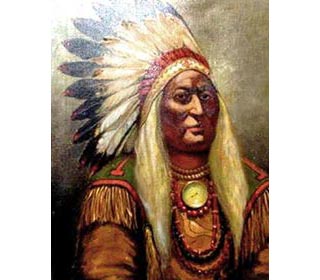The names of the Idaho tribes included the Lemhi Shoshone Bannock, Nez Perce, Salish (Flatheads), Paiutes and the Piegan Indians. The Snake River Plains Indians evolved into the Bannock and Shoshone tribes, whilst the Northern Idaho Natives evolved into the Nez Perce and other tribes. The Bannock originated in Western Idaho and spoke the Northern Paiute language. The Bannock tribe developed a horse culture and were closely associated with the Northern Shoshone with whom they eventually merged. Fast Facts about the History of Idaho Indians
The climate, land, history, environment and natural resources that were available to the indigenous Indian tribes in Idaho resulted in the adoption of the Northwest culture. In Northern Idaho some Indians adopted the Plateau Culture. - Name of State: Idaho
- Meaning of State name: Idaho is an invented word supposedly meaning the "gem of the mountains. George M. Willing, a mining lobbyist, suggested the 'Shoshone Indian word' of 'Idaho' meaning "Gem of the Mountains. Congress eventually became aware that the name was made up by this time the name had been adopted by popular consent.
- Geography, Environment and Characteristics of the State of Idaho: Plains in the south, central region of mountains, canyons, gorges; sub-alpine northern region.
- Culture adopted by Idaho Indians: Northwest Cultural Group. In Northern Idaho some Indians adopted the Plateau Culture
- Languages: Athabaskan, Algonquian, Siouan, Caddoan and Uto-Aztecan
- Way of Life (Lifestyle): Hunters and Fishers
- Types of housing, homes or shelters: Pit houses, tepees, tule-mat lodges
History Timeline of the Idaho Indians - 10,000 B.C. : Paleo-Indian Era (Stone Age culture) the earliest human inhabitants of America who lived in caves and were Nomadic hunters of large game including the Great Mammoth.
- 9000 BC: Clovis Culture (named after artefacts found at Clovis, New Mexico. These people used a distinctive type of fluted arrow point
- 7500 BC: Folsom Culture (named after artefacts found at Folsom, New Mexico. These people used flint arrow point in the shape of a leaf)
- 7000 BC: Archaic Period in which people built basic shelters and made stone weapons and stone tools
- 1501: The Spanish explorers claim lands for the Spanish monarchy
- 1775: 1775 - 1783 - The American Revolution.
- 1776: July 4, 1776 - United States Declaration of Independence
- 1803: The United States bought the Louisiana Territory from France for 15 million dollars for the land
- 1812: 1812 - 1815: The War of 1812 between U.S. and Great Britain, ended in a stalemate but confirmed America's Independence
- 1830: Indian Removal Act
- 1832: Department of Indian Affairs established
- 1846: Idaho becomes part of the United States
- 1858: Coeur d'Alene War (aka Spokane, Coeur d'Alene and Palouse Indian war) in the Washington and Idaho areas. Indians attacked and defeated a force of 164 US troops under Major Edward Steptoe.
- 1861: 1861 - 1865: The American Civil War.
- 1863: To punish the hostile Indians in Idaho, Fort Boise was established
- 1864: The Snake War (1864–1868) was fought by the U.S. army against the "Snake Indians" which was the settlers term for Northern Paiute, Bannock and Western Shoshone bands who lived along the Snake River
- 1865: The surrender of Robert E. Lee on April 9 1865 signalled the end of the Confederacy
- 1865: 1865-1868 - Campaign against Indians in southern Oregon, Idaho (Territory) and northern California.
- 1868: The Bannock tribe was restricted to the Fort Hall Reservation in Idaho. They experienced a terrible famine and broken treaties
- 1877: Nez Perce War in Oregon, Montana and Idaho. After fighting against the Americans. Chief Joseph led his tribe 1700 miles to Canada but were forced to to surrender near the border
- 1878: The Bannock Indian War
- 1879: The Sheepeater Indian War was the last Indian war fought in the Pacific Northwest portion of the United States in Idaho.
- 1879: The Native Indian tribes of Idaho surrender on September 1
- 1887: Dawes General Allotment Act passed by Congress leads to the break up of the large Indian Reservations and the sale of Indian lands to white settlers
- 1969: All Indians declared citizens of U.S.
- 1979: American Indian Religious Freedom Act was passed
History of Idaho Indians - Destruction and Decline
The history of the European invasion brought epidemic diseases such as tuberculosis, cholera, influenza, measles and smallpox. The Native Indians of Idaho had not developed immunities against these diseases resulting in huge losses in population. Exploitation including the leverage of taxes, enforced labor and enslavement were part of their history, taking their toll on the Idaho Indians. |
